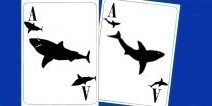|

Join our Newsletter
& get our free guide Starting Hands Revealed
We hate spam too!
We value your privacy and never share your email. All our emails have an opt-out link. Click it, and you will never hear from us again. pokerstars marketing code
in various languages
pokerstars review
in various languages
|
Optimal Play Against Loose-Passive PlayersThe best way to beat them
These are the guys who don't care what you have -- they're thinking on the 0th level. We refer to them, lovingly, as calling stations. And they should be a main source of our profit. But we see otherwise great players do strange things against calling stations. We see decent TAGs betting into loose-passive players with absolute air; as though the TAG had any fold equity to speak of. We see solid regulars raising crap like K4 offsuit to 'isolate' a fish; as though that play has any value whatsoever. We are going to cover the basics of optimal play against loose-passive opponents. We'll analyze the hand ranges we should expect such opponents to be playing with in different situations, and we'll take a look at how our own ranges can be optimized in context. By the time you're done reading, you'll have a solid grasp on how to exploit loose-passive fish. Loose-Passive Calling Ranges -- PreflopLet's define the ranges that would lead us to label a player loose-passive in the first place. The definition of a calling station is someone who rarely uses aggression, who calls with long-shot draws regardless of odds, and who is completely oblivious to anything but his own cards. Given this, we can expect a loose-passive player to have a large discrepancy between his VPIP and PFR statistics. So even if a player plays reasonably tight preflop, say 20%, he might not raise more than 2% of those hands; in which case he'd be something of a 'nitty' calling station. Other calling stations are just there to gamble, and you can tell. Imagine your drunk uncle playing the Saturday night home game -- call, call, call, call, call, and so on ad infinitum. These guys will have stats that look like 35/5, 40/2, and sometimes even higher. All of these players have one thing in common: their entire preflop range is a calling range. So we must adjust our own preflop range keeping this in mind. Loose-Passive Calling Ranges By The NumbersWith the help of PokerStove, let's run down what some typical loose-passive opponents' ranges might look like. We'll examine what a 20/5, a 35/5, and a 40/2 player would decide to play preflop.
Optimizing Your Preflop Range Against Calling StationsYou can see from the range breakdowns above that calling stations generally play a lot of potentially dominated hands. That is, hands like A-5 and K-6 that are one-upped by better aces or kings. That means you want your range to consist almost entirely of hands that dominate your opponent's garbage. What it does not mean is that you want to be aggressive with a wide range, thinking you'll 'outplay him postflop'. That's what gets so many decent players into trouble against calling stations. Calling stations aren't fazed by aggression; they just want to gamble. So being aggressive with trash like K6o against a station will only get you into trouble, and lots of it, since you'll be pumping cash into a pot with a hand that's just as likely to be dominated as your opponent's! So in general, it's best to sit back and wait for premium hands against a loose-passive type of player. Then, you pummel the calling station with bets -- pumping the pot as heavily as you can -- so that you get paid off handsomely when you dominate whatever crap he shows up with at showdown. Let's say we choose to raise a range of {22+, ATs+, KJs+, 9Ts+, AJo+, KQo} against a bad station. That's about 10% of our hands. Let's see how the range holds up against the player types we evaluated above, in terms of hot-and-cold equity.
Now let's see what happens if we open up our range a bit. We'll add any suited ace, any suited king, and A5o+ to our range.
Notice that as we widen our range, our range's equity decreases. This wouldn't be a problem against players who fold postflop -- we could play an aggressive game and take down pots. But calling stations don't fold. So when we widen our range, we pump a lot of money into pots that we simply won't take down on fold equity alone. We lose value constantly. If we raise preflop with K8o, for example, and the board comes A-K-7, we have no idea where we stand. Since villain has only one standard play -- calling -- our bets will give us no information. If villain has any ace, any king, or any 7, he's likely to call. So our value is quite thin. We do want to push it, since we have a pair and our opponent is bad enough to pay off worse, but if we had kept our preflop range tighter, we'd be a lock -- and we'd certainly make more money in the long-run.
Knowing how to think in terms of hand ranges can make it easier to understand how to beat calling stations at the tables; which improves our profits and confidence.
This is where some of the best players play online poker, like Vanessa Rousso, Liv Boeree, and many others. And the best players know how to make the most money from loose aggressive opponents. If you sign up at pokerstars, you can observe Vanessa Rousso playing poker there. Her username is 'LadyMaverick'. Or you can even play with her, if you dare.

|











